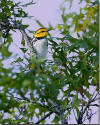

ENDANGERED SPECIES (Golden-Cheeked Warbler)
The environment where the Indian Creek Homes
are built is classified as golden-cheeked warbler habitat by the US Fish and Wildlife Service. (click on thumbnails) The golden-cheeked
warbler is classified as an endangered according to the
Endangered Species Act of 1973.
This law requires that certain species and their habitats identified as
endangered by US Fish and Wildlife shall be protected and conserved. The golden
cheeked warbler, which is
Wildlife Service. (click on thumbnails) The golden-cheeked
warbler is classified as an endangered according to the
Endangered Species Act of 1973.
This law requires that certain species and their habitats identified as
endangered by US Fish and Wildlife shall be protected and conserved. The golden
cheeked warbler, which is the only bird in Texas that only nests in Texas, is protected by what is called a
Section 10A permit from US Fish and Wildlife. This permit is known as the
Balcones Canyonlands Conservation Plan and is administered as the Balcones
Canyonland Preserve (BCP). This permit allows for 9 endangered species and
27 threatened species to be protected as described in the Endangered Species
Act. A series of preserves has been set up in Travis County to conserve the
habitat for these species. Individuals can also participate in the permit
by paying a fee to allow for their property to be developed as described in
further detail a little later on this page.
the only bird in Texas that only nests in Texas, is protected by what is called a
Section 10A permit from US Fish and Wildlife. This permit is known as the
Balcones Canyonlands Conservation Plan and is administered as the Balcones
Canyonland Preserve (BCP). This permit allows for 9 endangered species and
27 threatened species to be protected as described in the Endangered Species
Act. A series of preserves has been set up in Travis County to conserve the
habitat for these species. Individuals can also participate in the permit
by paying a fee to allow for their property to be developed as described in
further detail a little later on this page.
The Indian Creek Properties are identified as
"confirmed golden-cheeked warbler habitat" (GCW habitat) by the US Fish and Wildlife Service. Click on the thumbnail on the right and
notice that the bright yellow area signifies confirmed GCW habitat. Notice
how this area follows the canyon side edge of Indian Creek Road. That is
because the GCW prefers these big, heavily wooded canyons of the Hill Country.
US Fish and Wildlife Service. Click on the thumbnail on the right and
notice that the bright yellow area signifies confirmed GCW habitat. Notice
how this area follows the canyon side edge of Indian Creek Road. That is
because the GCW prefers these big, heavily wooded canyons of the Hill Country.
To be allowed to build homes in this habitat, the 10A permit issued by US Fish and Wildlife allows for a fee to be paid to the Balcones Canyonlands Preserve. This fee "mitigates for the take of habitat" as defined by the Endangered Species Act (ESA). Because the ESA requires that the golden-cheeked warbler and its habitat be conserved, one can not, under penalty of law, harm this bird or its habitat. The fee paid to the Balcones Canyonlands Preserve allows for this habitat to be used for some other reason than to grow GCWs.
 This
is what has happened on these three lots. a $4,200 fee was paid to the BCP
to mitigate for the take of the habitat.
This
is what has happened on these three lots. a $4,200 fee was paid to the BCP
to mitigate for the take of the habitat.
 This
doesn't mean that any GCWs were harmed. Only their habitat was disrupted.
No GCWs have been mapped in this general area in a number of years. However, the
ESA still requires, because the habitat is appropriate, that it be protected in
case GCWs want to utilize the area. And even though a fee has been paid
and some of the trees have been removed, and houses have been built,
golden-cheeked warblers may still utilize the area.
This
doesn't mean that any GCWs were harmed. Only their habitat was disrupted.
No GCWs have been mapped in this general area in a number of years. However, the
ESA still requires, because the habitat is appropriate, that it be protected in
case GCWs want to utilize the area. And even though a fee has been paid
and some of the trees have been removed, and houses have been built,
golden-cheeked warblers may still utilize the area.
The owner of the Indian Creek properties has
surveyed for GCWs with US Fish and Wildlife, LCRA and Travis County biologists
in many areas
and has seen them many times. An official survey was not performed, nor were the
birds seen at other times last year at the Indian Creek homes, but
that doesn't mean they were not there, or that they will not utilize the area in
future years.
Look and listen for golden-cheeked warblers in the early to mid spring. keep your binoculars and a bird book handy, because you never know...
GCWs don't use bird feeders, although if in the area, they may check them out for bugs. Your best bet for seeing a GCW on the property is to listen to the above song file until you know the GCW call, then keep your ears open when you are outside. If you hear the song, grab your binocs and take off!
Links:
City of Austin Balcones Canyonland Preserve
Travis County Natural Resources Balcones Canyonland Preserve
Lower Colorado river Authority Balcones Canyonlands Preserve